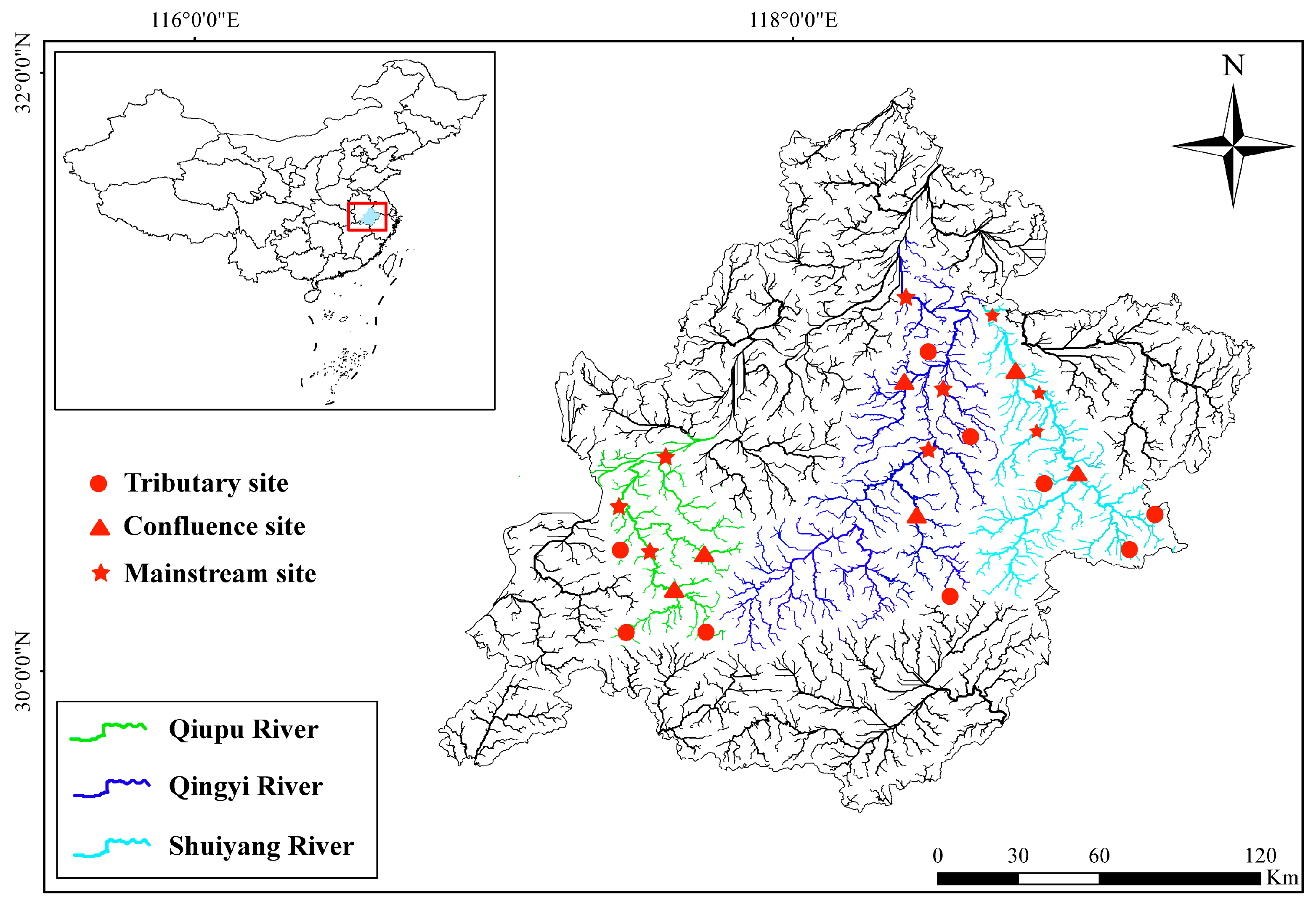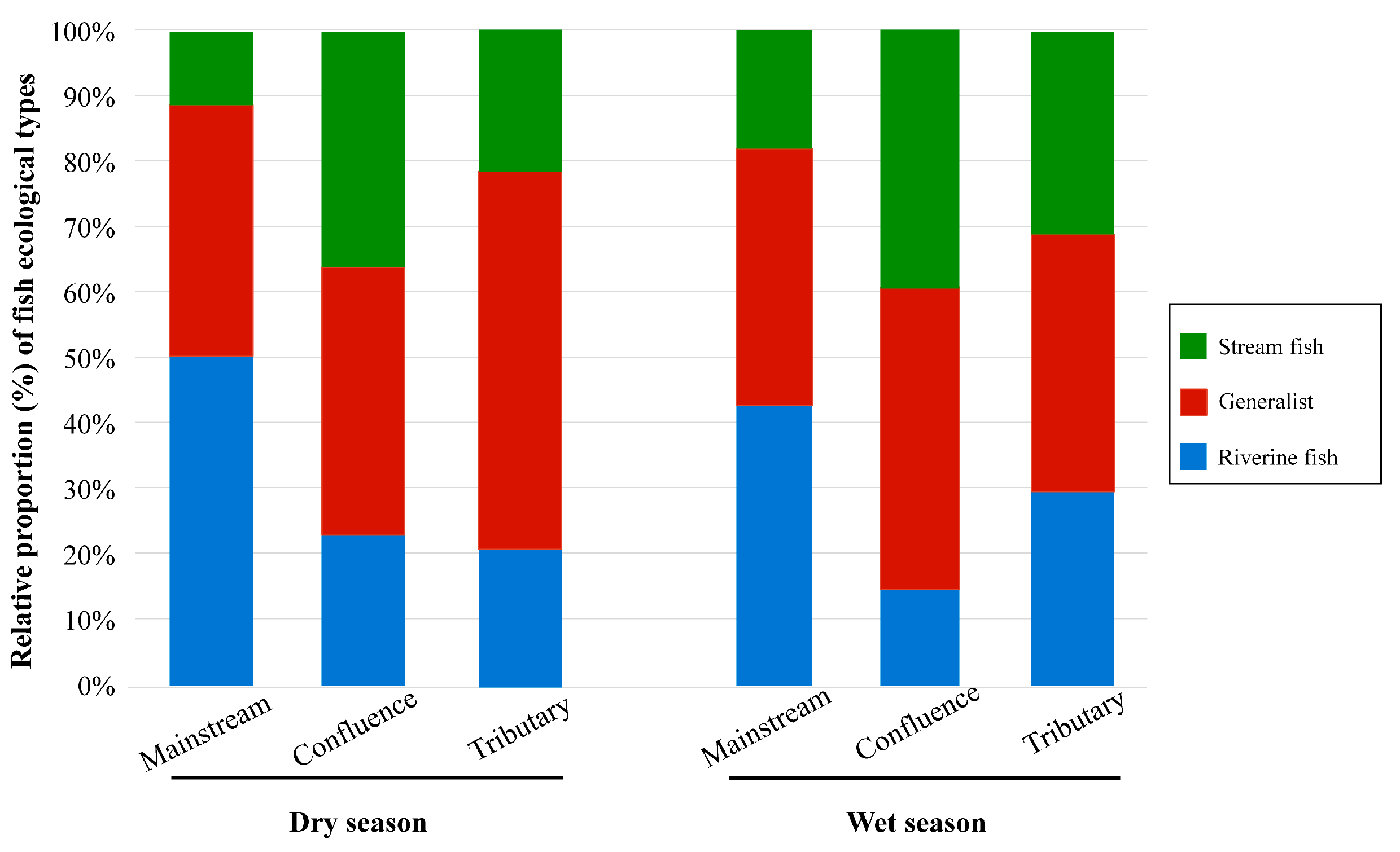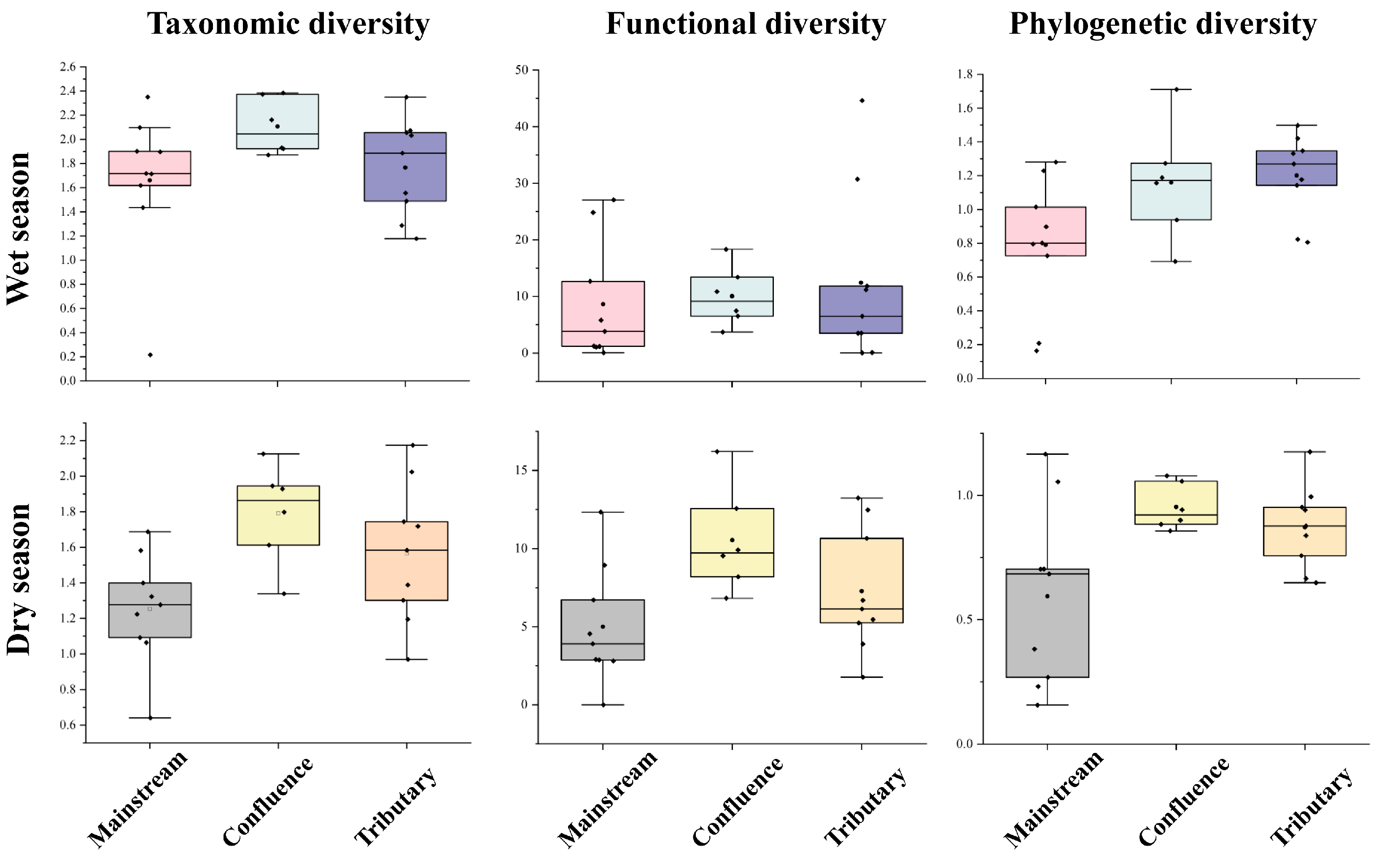Revealing the Structure and Biodiversity Patterns of Fish Communities in River Networks Based on Environmental DNA
Abstract
1. Introduction
2. Materials and Methods
2.1. Study Area and Sampling Sites
2.2. Water Sample Collection
2.2.1. Collection and Processing of eDNA
2.2.2. Functional Traits
2.2.3. Phylogenetic Tree Construction
2.2.4. Data Analysis
3. Results
4. Discussion
4.1. Comparison of eDNA Metabarcoding and Traditional Monitoring in the WMR
4.2. Variations in Fish Community Composition and Biodiversity Across Different Habitats
5. Conclusions
Supplementary Materials
Author Contributions
Funding
Institutional Review Board Statement
Informed Consent Statement
Data Availability Statement
Acknowledgments
Conflicts of Interest
References
- Hiddink, J.G.; MacKenzie, B.R.; Rijnsdorp, A.; Dulvy, N.K.; Nielsen, E.E.; Bekkevold, D.; Heino, M.; Lorance, P.; Ojaveer, H. Importance of fish biodiversity for the management of fisheries and ecosystems. Fish. Res. 2008, 90, 6–8. [Google Scholar] [CrossRef]
- McIntyre, P.B.; Reidy Liermann, C.A.; Revenga, C. Linking freshwater fishery management to global food security and biodiversity conservation. Proc. Natl. Acad. Sci. USA 2016, 113, 12880–12885. [Google Scholar] [CrossRef] [PubMed]
- Dudgeon, D.; Arthington, A.H.; Gessner, M.O.; Kawabata, Z.I.; Knowler, D.J.; Lévêque, C.; Sullivan, C.A. Freshwater biodiversity: Importance, threats, status and conservation challenges. Biol. Rev. 2006, 81, 163–182. [Google Scholar] [CrossRef] [PubMed]
- Reid, A.J.; Carlson, A.K.; Creed, I.F.; Eliason, E.J.; Gell, P.A.; Johnson, P.T.; Cooke, S.J. Emerging threats and persistent conservation challenges for freshwater biodiversity. Biol. Rev. 2019, 94, 849–873. [Google Scholar] [CrossRef] [PubMed]
- Su, G.; Logez, M.; Xu, J.; Tao, S.; Villéger, S.; Brosse, S. Human impacts on global freshwater fish biodiversity. Science 2021, 371, 835–838. [Google Scholar] [CrossRef]
- Altermatt, F. Diversity in riverine metacommunities: A network perspective. Aquat. Ecol. 2013, 47, 365–377. [Google Scholar] [CrossRef]
- McGill, B.J.; Dornelas, M.; Gotelli, N.J.; Magurran, A.E. Fifteen forms of biodiversity trend in the Anthropocene. Trends Ecol. Evol. 2015, 30, 104–113. [Google Scholar] [CrossRef]
- Brumm, K.J.; Hanks, R.D.; Baldwin, R.F.; Peoples, B.K. Accounting for multiple dimensions of biodiversity to assess surrogate performance in a freshwater conservation prioritization. Ecol. Indic. 2021, 122, 107320. [Google Scholar] [CrossRef]
- Wang, J.; Chen, L.; Tang, W.; Heino, J.; Jiang, X. Effects of dam construction and fish invasion on the species, functional and phylogenetic diversity of fish assemblages in the Yellow River Basin. J. Environ. Manag. 2021, 293, 112863. [Google Scholar] [CrossRef]
- Pollock, L.J.; Thuiller, W.; Jetz, W. Large conservation gains possible for global biodiversity facets. Nature 2017, 546, 141–144. [Google Scholar] [CrossRef]
- Zhang, C.; Zhu, R.; Sui, X.; Li, X.; Chen, Y. Understanding patterns of taxonomic diversity, functional diversity, and ecological drivers of fish fauna in the Mekong River. Glob. Ecol. Conserv. 2021, 28, e01711. [Google Scholar] [CrossRef]
- Strecker, A.L.; Olden, J.D.; Whittier, J.B.; Paukert, C.P. Defining conservation priorities for freshwater fishes according to taxonomic, functional, and phylogenetic diversity. Ecol. Appl. 2011, 21, 3002–3013. [Google Scholar] [CrossRef]
- Lin, L.; Deng, W.; Huang, X.; Kang, B. Fish taxonomic, functional, and phylogenetic diversity and their vulnerabilities in the largest river in southeastern China. Ecol. Evol. 2021, 11, 11533–11548. [Google Scholar] [CrossRef] [PubMed]
- Villéger, S.; Brosse, S.; Mouchet, M.; Mouillot, D.; Vanni, M.J. Functional ecology of fish: Current approaches and future challenges. Aquat. Sci. 2017, 79, 783–801. [Google Scholar] [CrossRef]
- Winter, M.; Devictor, V.; Schweiger, O. Phylogenetic diversity and nature conservation: Where are we? Trends Ecol. Evol. 2013, 28, 199–204. [Google Scholar] [CrossRef] [PubMed]
- Blanchet, S.; Helmus, M.R.; Brosse, S.; Grenouillet, G. Regional vs. local drivers of phylogenetic and species diversity in stream fish communities. Freshw. Biol. 2014, 59, 450–462. [Google Scholar] [CrossRef]
- Wang, S.; Yan, Z.; Hänfling, B.; Zheng, X.; Wang, P.; Fan, J.; Li, J. Methodology of fish eDNA and its applications in ecology and environment. Sci. Total Environ. 2021, 755, 142622. [Google Scholar] [CrossRef]
- Lin, L.; Liu, Y.; Lin, H.; Kang, B. Considering species functional and phylogenetic rarity in the conservation of fish biodiversity. Divers. Distrib. 2024, 30, e13804. [Google Scholar] [CrossRef]
- Fernandes, C.C.; Podos, J.; Lundberg, J.G. Amazonian ecology: Tributaries enhance the diversity of electric fishes. Science 2004, 305, 1960–1962. [Google Scholar] [CrossRef]
- Doretto, A.; Piano, E.; Larson, C.E. The River Continuum Concept: Lessons from the past and perspectives for the future. Can. J. Fish. Aquat. Sci. 2020, 77, 1853–1864. [Google Scholar] [CrossRef]
- Rice, S.P.; Kiffney, P.; Greene, C.; Pess, G.R. The ecological importance of tributaries and confluences. In River Confluences, Tributaries and the Fluvial Network; John Wiley & Sons: Chichester, UK, 2008; pp. 209–226. [Google Scholar]
- Boddy, N.C.; Booker, D.J.; McIntosh, A.R. Confluence configuration of river networks controls spatial patterns in fish communities. Landsc. Ecol. 2019, 34, 187–201. [Google Scholar] [CrossRef]
- Grant, E.H.C.; Lowe, W.H.; Fagan, W.F. Living in the branches: Population dynamics and ecological processes in dendritic networks. Ecol. Lett. 2007, 10, 165–175. [Google Scholar] [CrossRef]
- Yuan, S.; Qiu, J.; Tang, H.; Xu, L.; Xiao, Y.; Liu, M.; Gualtieri, C. Fish community traits near a large confluence: Implications for its nodal effects in the river ecosystem. J. Hydrol. 2023, 626, 130335. [Google Scholar] [CrossRef]
- Czeglédi, I.; Sály, P.; Takács, P.; Dolezsai, A.; Nagy, S.A.; Erős, T. The scales of variability of stream fish assemblages at tributary confluences. Aquat. Sci. 2016, 78, 641–654. [Google Scholar] [CrossRef]
- Duarte, C.; Antão, L.H.; Magurran, A.E.; de Deus, C.P. Shifts in fish community composition and structure linked to seasonality in a tropical river. Freshw. Biol. 2022, 67, 1789–1800. [Google Scholar] [CrossRef]
- Shen, Y.; Zhou, X.; Zhang, Y.; Zhang, J.; Li, Q.; Chen, Q.; Luo, Y. Important fish diversity maintenance status of the tributaries in a hotspot fish conservation area in the upper Yangtze River revealed by eDNA metabarcoding. Sci. Rep. 2024, 14, 24128. [Google Scholar] [CrossRef] [PubMed]
- Yao, M.; Zhang, S.; Lu, Q.; Chen, X.; Zhang, S.Y.; Kong, Y.; Zhao, J. Fishing for fish environmental DNA: Ecological applications, methodological considerations, surveying designs, and ways forward. Mol. Ecol. 2022, 31, 5132–5164. [Google Scholar] [CrossRef]
- Marques, V.; Castagné, P.; Polanco, A.; Borrero-Pérez, G.H.; Hocdé, R.; Guérin, P.É.; Villéger, S. Use of environmental DNA in assessment of fish functional and phylogenetic diversity. Conserv. Biol. 2021, 35, 1944–1956. [Google Scholar] [CrossRef]
- Condachou, C.; Milhau, T.; Murienne, J.; Brosse, S.; Villéger, S.; Valentini, A.; Mouillot, D. Inferring functional diversity from environmental DNA metabarcoding. Environ. DNA 2023, 5, 934–944. [Google Scholar] [CrossRef]
- Gu, S.; Deng, Y.; Wang, P.; Li, C.; Shi, D.; Wang, S. Assessing riverine fish community diversity and stability by eDNA metabarcoding. Ecol. Indic. 2023, 157, 111222. [Google Scholar] [CrossRef]
- Strahler, A.N. Quantitative analysis of watershed geomorphology. Eos Trans. AGU 1957, 38, 913–920. [Google Scholar]
- Balasingham, K.D.; Walter, R.P.; Mandrak, N.E.; Heath, D.D. Environmental DNA detection of rare and invasive fish species in two Great Lakes tributaries. Mol. Ecol. 2018, 27, 112–127. [Google Scholar] [CrossRef]
- Zhang, S.; Zhao, J.; Yao, M. A comprehensive and comparative evaluation of primers for metabarcoding eDNA from fish. Methods Ecol. Evol. 2020, 11, 1609–1625. [Google Scholar] [CrossRef]
- Taberlet, P.; Coissac, E.; Pompanon, F.; Brochmann, C.; Willerslev, E. Towards next-generation biodiversity assessment using DNA metabarcoding. Mol. Ecol. 2012, 21, 2045–2050. [Google Scholar] [CrossRef] [PubMed]
- Bolger, A.M.; Lohse, M.; Usadel, B. Trimmomatic: A flexible trimmer for Illumina sequence data. Bioinformatics 2014, 30, 2114–2120. [Google Scholar] [CrossRef] [PubMed]
- Magoč, T.; Salzberg, S.L. FLASH: Fast length adjustment of short reads to improve genome assemblies. Bioinformatics 2011, 27, 2957–2963. [Google Scholar] [CrossRef]
- Edgar, R.C. Search and clustering orders of magnitude faster than BLAST. Bioinformatics 2010, 26, 2460–2461. [Google Scholar] [CrossRef]
- Zhang, S.; Zheng, Y.; Zhan, A.; Dong, C.; Zhao, J.; Yao, M. Environmental DNA captures native and non-native fish community variations across the lentic and lotic systems of a megacity. Sci. Adv. 2022, 8, eabk0097. [Google Scholar] [CrossRef]
- Zou, K.; Chen, J.; Ruan, H.; Li, Z.; Guo, W.; Li, M.; Liu, L. eDNA metabarcoding as a promising conservation tool for monitoring fish diversity in a coastal wetland of the Pearl River Estuary compared to bottom trawling. Sci. Total Environ. 2020, 702, 134704. [Google Scholar] [CrossRef]
- Liu, Z.; Hu, C.; You, W.; Li, S.; Wu, Y.; Liang, Y.; Chu, L.; Yan, Y.; Zhang, C. Comparison between environmental DNA metabarcoding and traditional survey method to identify community composition and assembly of stream fish. Ecol. Evol. 2024, 14, e70627. [Google Scholar] [CrossRef]
- Li, F.; Zhang, Y.; Altermatt, F.; Yang, J.; Zhang, X. The effects of environmental factors on species interactions in urban ecosystems. Environ. Sci. Technol. 2023, 57, 7828–7839. [Google Scholar] [CrossRef]
- Yan, Y.; Wang, H.; Zhu, R.; Chu, L.; Chen, Y. Influences of low-head dams on the fish assemblages in the headwater streams of the Qingyi watershed, China. Environ. Biol. Fish. 2013, 96, 495–506. [Google Scholar] [CrossRef]
- Li, Q.; Li, Y.; Jiang, M.; Wang, Y.; Xu, D.; Chu, L.; Yan, Y. Effects of low-head dams on fish assemblages in subtropical streams: Context dependence on local habitat and landscape conditions. Ecol. Indic. 2021, 121, 107190. [Google Scholar] [CrossRef]
- Stamatakis, A. RAxML-VI-HPC: Maximum likelihood-based phylogenetic analyses with thousands of taxa and mixed models. Bioinformatics 2006, 22, 2688–2690. [Google Scholar] [CrossRef]
- Robinson, D.F.; Foulds, L.R. Comparison of phylogenetic trees. Math. Biosci. 1981, 53, 131–147. [Google Scholar] [CrossRef]
- Hillis, D.M.; Bull, J.J. An empirical test of bootstrapping as a method for assessing confidence in phylogenetic analysis. Syst. Biol. 1993, 42, 182–192. [Google Scholar] [CrossRef]
- Kumar, S.; Stecher, G.; Li, M.; Knyaz, C.; Tamura, K. MEGA7: Molecular Evolutionary Genetics Analysis Version 7.0 for bigger datasets. Mol. Biol. Evol. 2016, 33, 1870–1874. [Google Scholar] [CrossRef]
- Chen, H.; Boutros, P.C. VennDiagram: A package for the generation of highly-customizable Venn and Euler diagrams in R. BMC Bioinform. 2011, 12, 35. [Google Scholar] [CrossRef]
- Oksanen, J.; Blanchet, F.G.; Kindt, R.; Legendre, P.; Minchin, P.R.; O’Hara, B.; Simpson, G.L.; Solymos, P.; Stevens, M.H.H.; Wagner, H. Vegan: Community Ecology Package. R Package Version 2015, 2, 321–326. [Google Scholar]
- Cornwell, W.K.; Schwilk, D.W.; Ackerly, D.D. A trait-based test for habitat filtering: Convex hull volume. Ecology 2006, 87, 1465–1471. [Google Scholar] [CrossRef]
- Faith, D.P. Conservation evaluation and phylogenetic diversity. Biol. Conserv. 1992, 61, 1–10. [Google Scholar] [CrossRef]
- Magneville, C.; Loiseau, N.; Albouy, C.; Casajus, N.; Claverie, T.; Escalas, A.; Leprieur, F.; Maire, E.; Mouillot, D.; Villéger, S. mFD: An R package to compute and illustrate the multiple facets of functional diversity. Ecography 2022, 2022, e05904. [Google Scholar] [CrossRef]
- Kembel, S.W.; Cowan, P.D.; Helmus, M.R.; Cornwell, W.K.; Morlon, H.; Ackerly, D.D. Picante: R tools for integrating phylogenies and ecology. Bioinformatics 2010, 26, 1463–1464. [Google Scholar] [CrossRef] [PubMed]
- Zimmerman, D.W.; Zumbo, B.D. The effect of violating the homogeneity of variance assumption in analysis of variance. J. Exp. Educ. 1993, 61, 55–67. [Google Scholar]
- R Core Team. R: A Language and Environment for Statistical Computing; R Foundation for Statistical Computing: Vienna, Austria, 2023. [Google Scholar]
- Zhang, D.; Qiao, J.; He, J.; Chu, L.; Yan, Y. A longitudinal gradient in the taxonomic, functional, and phylogenetic diversity of freshwater fish in a subtropical river system. Hydrobiologia 2023, 850, 1175–1187. [Google Scholar] [CrossRef]
- Diao, Z.; Shen, J. Fishes and their geographical distribution in the mountainous areas of southern Anhui. Anhui Agric. Sci. 1981, 1, 82–88. [Google Scholar]
- Chang, C.H.; Li, F.; Shao, K.T.; Lin, Y.S.; Morosawa, T.; Kim, S.; Koo, H.; Kim, W.; Lee, J.-S.; Mayden, R.L.; et al. Phylogenetic relationships of Acheilognathidae (Cypriniformes: Cyprinoidea) as revealed from evidence of both nuclear and mitochondrial gene sequence variation: Evidence for necessary taxonomic revision in the family and the identification of cryptic species. Mol. Phylogenet. Evol. 2014, 81, 182–194. [Google Scholar]
- Duarte, S.; Simões, L.; Costa, F.O. Current status and topical issues on the use of eDNA-based targeted detection of rare animal species. Sci. Total Environ. 2023, 872, 166675. [Google Scholar] [CrossRef]
- Turner, C.R.; Uy, K.L.; Everhart, R.C. Fish environmental DNA is more concentrated in aquatic sediments than surface water. Biol. Conserv. 2015, 183, 93–102. [Google Scholar] [CrossRef]
- Sakata, M.K.; Watanabe, T.; Maki, N.; Ikeda, K.; Kosuge, T.; Okada, H.; Minamoto, T. Determining an effective sampling method for eDNA metabarcoding: A case study for fish biodiversity monitoring in a small, natural river. Limnology 2021, 22, 221–235. [Google Scholar] [CrossRef]
- Guillera-Arroita, G.; Lahoz-Monfort, J.J.; van Rooyen, A.R.; Weeks, A.R.; Tingley, R. Dealing with false-positive and false-negative errors about species occurrence at multiple levels. Methods Ecol. Evol. 2017, 8, 1081–1091. [Google Scholar] [CrossRef]
- Furlan, E.M.; Gleeson, D.; Hardy, C.M.; Duncan, R.P. A framework for estimating the sensitivity of eDNA surveys. Mol. Ecol. Resour. 2016, 16, 641–654. [Google Scholar] [CrossRef] [PubMed]
- Jerde, C.L. Can we manage fisheries with the inherent uncertainty from eDNA? J. Fish Biol. 2021, 98, 341–353. [Google Scholar] [CrossRef]
- Burian, A.; Mauvisseau, Q.; Bulling, M.; Domisch, S.; Qian, S.; Sweet, M. Improving the reliability of eDNA data interpretation. Mol. Ecol. Resour. 2021, 21, 1422–1433. [Google Scholar] [CrossRef] [PubMed]
- Li, Q.; Zhang, Y.; Wang, R.; Chu, L.; Li, Y.; Yan, Y. Low-head dams induce biotic homogenization/differentiation of fish assemblages in subtropical streams. Ecol. Evol. 2022, 12, e9156. [Google Scholar] [CrossRef]
- Kong, D.; Cui, G.; Yang, J. Threatened fishes of the world: Pseudorasbora elongata Wu, 1939 (Cyprinidae). Environ. Biol. Fish. 2006, 76, 107–108. [Google Scholar]
- Radinger, J.; Wolter, C. Patterns and predictors of fish dispersal in rivers. Fish Fish. 2014, 15, 456–473. [Google Scholar] [CrossRef]
- Cathcart, C.N.; Gido, K.B.; McKinstry, M.C.; MacKinnon, P.D. Patterns of fish movement at a desert river confluence. Ecol. Freshw. Fish 2018, 27, 492–505. [Google Scholar] [CrossRef]
- Penaluna, B.E.; Allen, J.M.; Arismendi, I.; Levi, T.; Garcia, T.S.; Walter, J.K. Better boundaries: Identifying the upper extent of fish distributions in forested streams using eDNA and electrofishing. Ecosphere 2021, 12, e03332. [Google Scholar] [CrossRef]
- Starcevich, S.J.; Howell, P.J.; Jacobs, S.E.; Sankovich, P.M. Seasonal movement and distribution of fluvial adult bull trout in selected watersheds in the mid-Columbia River and Snake River basins. PLoS ONE 2012, 7, e37257. [Google Scholar] [CrossRef]
- He, T.; Li, X.; Zheng, Y.; Liu, J. Comparative analysis of fish distribution between main stream and tributaries in Chongqing district of the Yangtze River. Freshw. Fish. 2016, 46, 47–51. [Google Scholar]
- Rice, S.P. Tributary connectivity, confluence aggradation and network biodiversity. Geomorphology 2017, 277, 6–16. [Google Scholar] [CrossRef]





Disclaimer/Publisher’s Note: The statements, opinions and data contained in all publications are solely those of the individual author(s) and contributor(s) and not of MDPI and/or the editor(s). MDPI and/or the editor(s) disclaim responsibility for any injury to people or property resulting from any ideas, methods, instructions or products referred to in the content. |
© 2025 by the authors. Licensee MDPI, Basel, Switzerland. This article is an open access article distributed under the terms and conditions of the Creative Commons Attribution (CC BY) license (https://creativecommons.org/licenses/by/4.0/).
Share and Cite
Liu, Z.; Wu, Y.; You, W.; Li, S.; Shi, G.; Zhang, C. Revealing the Structure and Biodiversity Patterns of Fish Communities in River Networks Based on Environmental DNA. Fishes 2025, 10, 175. https://doi.org/10.3390/fishes10040175
Liu Z, Wu Y, You W, Li S, Shi G, Zhang C. Revealing the Structure and Biodiversity Patterns of Fish Communities in River Networks Based on Environmental DNA. Fishes. 2025; 10(4):175. https://doi.org/10.3390/fishes10040175
Chicago/Turabian StyleLiu, Ziyu, Yongsheng Wu, Wenhui You, Shuxin Li, Ge Shi, and Chen Zhang. 2025. "Revealing the Structure and Biodiversity Patterns of Fish Communities in River Networks Based on Environmental DNA" Fishes 10, no. 4: 175. https://doi.org/10.3390/fishes10040175
APA StyleLiu, Z., Wu, Y., You, W., Li, S., Shi, G., & Zhang, C. (2025). Revealing the Structure and Biodiversity Patterns of Fish Communities in River Networks Based on Environmental DNA. Fishes, 10(4), 175. https://doi.org/10.3390/fishes10040175





